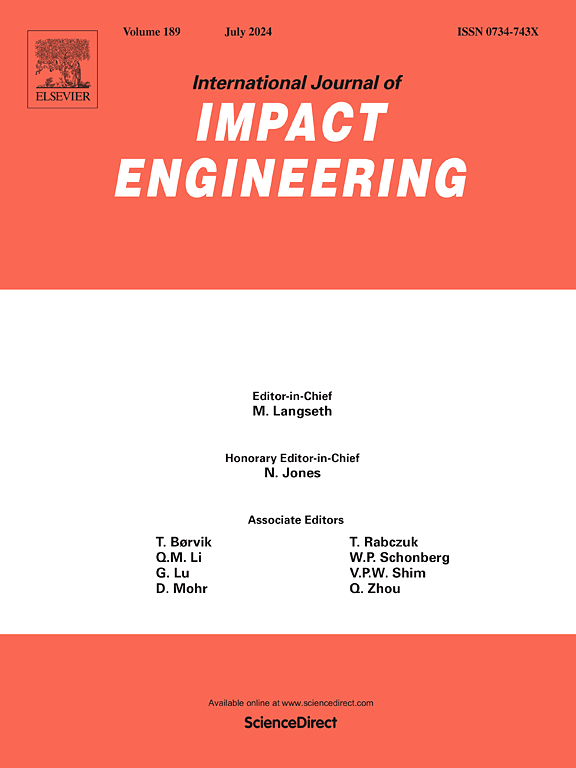Experimental characterization and plastic modeling of polycarbonate at static and dynamic rates
IF 5.1
2区 工程技术
Q1 ENGINEERING, MECHANICAL
International Journal of Impact Engineering
Pub Date : 2025-04-01
DOI:10.1016/j.ijimpeng.2025.105329
引用次数: 0
Abstract
Polycarbonate is widely used for impact protections, therefore it is of crucial interest to adequately characterize its elastoplastic response extended up to the effective ultimate local strains, at static and dynamic rates.
The mechanical response of polycarbonate includes some peculiarities in common with other polymers, making the experimental and postprocessing procedures for its hardening derivation somehow more complex than they are for metals. The two main aspects still requiring further understanding and modeling efforts are: firstly the non-monotonic stress-strain response exhibiting a peak, a drop and the successive increase of the stress-strain curves; secondly the transition between three very different straining modes including the initial uniform straining, the successive necking-induced strain localization and the final strain propagation, where the necked region progressively extends all over the tensile specimen while the already-necked zones of the specimen slow down their evolution and nearly stop deforming further.
The special deformation modes of polycarbonate induce local hydrostatic stresses evolving from negative to positive, consequently affecting the relationship between the measurable true stress and the not-measurable flow stress.
Especially in dynamic tests, the above straining features also induce increasing-decreasing trends of the effective local strain rate, whose effects would require to be properly quantified by experiments and included in the modeling strategy.
The present work identifies a procedure for deriving the flow curves of polycarbonate at static - dynamic rates by correcting the experimental true curves, and proposes this approach to investigate the strain rate effect on the material hardening
聚碳酸酯在静态和动态速率下的实验表征和塑性建模
聚碳酸酯广泛用于冲击防护,因此,在静态和动态速率下,充分表征其扩展到有效极限局部应变的弹塑性响应是至关重要的。聚碳酸酯的力学响应包括一些与其他聚合物共同的特性,这使得其硬化衍生的实验和后处理程序在某种程度上比金属更为复杂。需要进一步理解和建模的两个主要方面是:一是应力应变曲线呈现峰值、下降和连续上升的非单调应力应变响应;其次是三种不同的应变模式之间的过渡,包括初始的均匀应变,连续的颈状应变局部化和最终的应变扩展,其中颈状区域逐渐扩展到整个拉伸试样,而试件的已经颈状区域则减缓其演变并几乎停止变形。聚碳酸酯的特殊变形模式导致局部静水应力由负向正演变,从而影响可测真应力与不可测流变应力之间的关系。特别是在动态试验中,上述应变特征还会引起局部有效应变率的增减趋势,需要通过实验对其影响进行适当的量化,并纳入建模策略。本文提出了一种通过修正实验真值曲线来推导聚碳酸酯在静态-动态速率下的流动曲线的方法,并提出了这种方法来研究应变速率对材料硬化的影响
本文章由计算机程序翻译,如有差异,请以英文原文为准。
求助全文
约1分钟内获得全文
求助全文
来源期刊

International Journal of Impact Engineering
工程技术-工程:机械
CiteScore
8.70
自引率
13.70%
发文量
241
审稿时长
52 days
期刊介绍:
The International Journal of Impact Engineering, established in 1983 publishes original research findings related to the response of structures, components and materials subjected to impact, blast and high-rate loading. Areas relevant to the journal encompass the following general topics and those associated with them:
-Behaviour and failure of structures and materials under impact and blast loading
-Systems for protection and absorption of impact and blast loading
-Terminal ballistics
-Dynamic behaviour and failure of materials including plasticity and fracture
-Stress waves
-Structural crashworthiness
-High-rate mechanical and forming processes
-Impact, blast and high-rate loading/measurement techniques and their applications
 求助内容:
求助内容: 应助结果提醒方式:
应助结果提醒方式:


